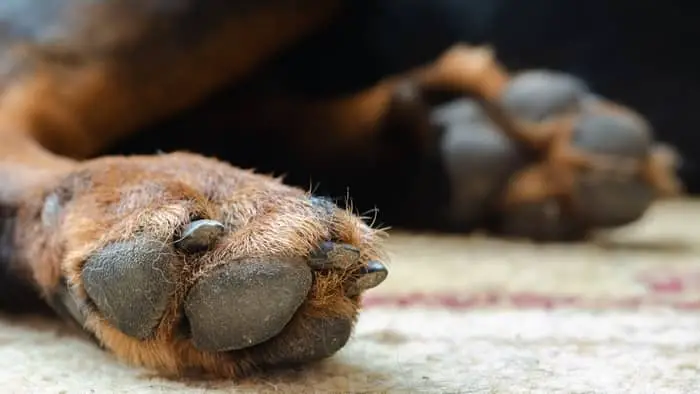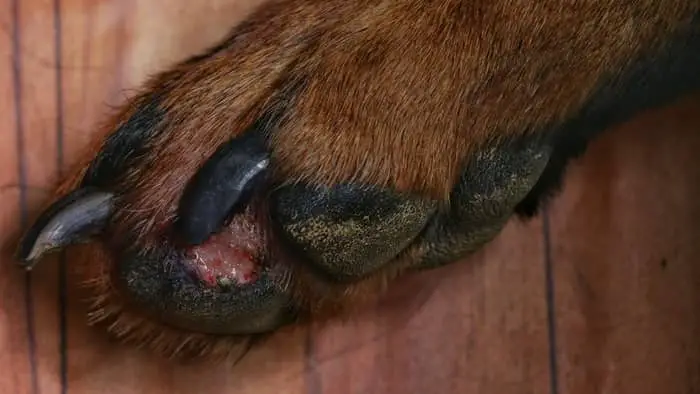Last Updated on April 24, 2024 by Dr. Julie
A dog’s webbed feet, despite many dogs not liking water, is an intriguing characteristic, making owners wonder why do dogs have webbed feet. These webs, however, aren’t the only interesting physical characteristic of dogs. In today’s article, we’ll be taking a closer look at dogs, learning why they have webbed feet, and taking a look at some other interesting characteristics.
Table of Contents
Do All Dogs Have Webbed Feet?
Even though most dogs don’t spend their time in the water, they still have webbing in their feet. Why is this? Well, it’s most likely an evolutionary trait that’s been leftover – similar to how we have a bit of skin between our fingers. This webbing is much more common among birds that spend their time in the water – ducks, seagulls, geese, etc.
Webbed feet are useful because they enlarge the size of their feet, grabbing more water when swimming. This makes them better swimmers! Dogs, however, don’t have overdeveloped webbed feet! This is because they’re terrestrial animals – they have evolved to be quick on the ground. Ducks and seagulls, in comparison, have to be quick in both air and water! That’s why a dog’s webbing isn’t as developed as the webbing of a duck!
Even though all dogs have some webbing, not all dogs have the same amount of webbing on their feet!
This is most likely the direct result of selective breeding! With time, we have managed to develop some breeds with greater feet webbing, while other breeds have less webbing. However, even breeds with the least webbing between their toes still have some webbing!
Which Dogs Have Webbed Feet?
Here are a few of the most popular breeds with webbed feet!
Portuguese water dogs
Given the name of these dogs, it’s no wonder they have well-developed feet webbing. These dogs were bred with the idea of helping fishermen force fish into their nets – similar to how shepherds force cattle to move around. This sort of job obviously entails a lot of swimming, which is why these dogs have such developed webbing!
Otterhounds
These dogs spent the largest part of their lives hunting otters in England – an activity that is now illegal. Since otters spend basically all of their time in the water or around it, these dogs had to do a lot of swimming in order to chase or catch an otter. Because of this, they developed a lot of webbing to help their swimming!
You can now notice the pattern – people bred dogs to help them out with their everyday tasks, and hunting was (and still is) part of that. This breed was not only bred to be a great swimmer, but also to withstand freezing temperatures. Their incredibly thick fur allowed them to help hunters looking for waterfowl in the area of the Great Lakes! They’re considered as some of the quickest swimming dog breeds in existence!
German shorthaired pointer
This breed is one of the most popular breeds among hunters around Europe. These dogs are incredible trackers and pointers, specialized for waterfowl hunting. Part of that job entails retrieving waterfowl from water once the hunter shoots it, so it’s no wonder that they’re incredible swimmers. What’s interesting about them is that enjoy sending time in the water even if they aren’t hunting!
Some other more popular breeds with webbed feet are Poodles, Cocker spaniels, Goldendoodles, Golden Retrievers, and Labrador Retrievers, as well as the Newfoundland dog.
Interestingly, there are many species of dogs with less developed webbing! German Shepherds, Bulldogs, Pitbulls, Boxers, Bullmastiffs, and the Rottweiler all belong on that list!
Webbed Feet In Dogs: Advantages And Disadvantages
When we’re discussing the advantages of webbed feet, it may be surprising that swimming isn’t the only one! Webbed feet also help with digging and handling rough terrain, with a few disadvantages as well!
Swimming prodigies
As we already explained, the webbing between their toes turns their paws in a sort of paddle, allowing dogs to swim much faster.
Read more about The Best Life Jacket For Rottweiler When Swimming.
Handling rough terrain
The webbing on their feet is also useful when it comes to handling rough terrain because it’s more difficult for them to slip! They’re also less likely to get stuck in a muddy area. If you’re going to be taking your dog on walks in muddy areas, then know dogs with well-webbed feet will handle that terrain much better!
The same applies for walking on snow – dogs with thick webbing on their feet are less likely to sink through the snow and they’ll keep stability with more ease!
More effective digging
Similar to how their feet act like paddles because of the webbing, they can also act like shovels when they’re digging! There’s more area because of the webbing, allowing for more efficient digging as they focus on their webs, instead of their claws!
There aren’t many disadvantages of having webbed feet, but here are some of the more obvious ones.
Possible health concerns
Even though it’s nothing too common – foot webbing increases the chances of developing arthritis. Dogs with webbed feet also seem to have more trouble with ticks and other parasites. Because of the webbing, they find an easy path to get between the pads!
Snow getting stuck between the pads
This is a very specific problem for dogs with webbing, but when they walk on snow, they can have snow stuck between the pads. This is a problem for two reasons: firstly, that snow will melt and they’ll leave traces of water around your home and secondly, there’s a small chance of frostbite!
In Conclusion
Webbed feet are a great tool for swimming. However, they’re also useful for digging and walking on difficult terrain. Aside from some minor problems, webbed feet are usually only useful for dogs, with most dogs having webbed feet. Some dogs, like the German Shorthaired Pointer or the Poodle, have well-developed webbed feet. This usually makes them great swimmers, while other breeds with less developed webbed feet aren’t as good at swimming.
With some dogs, this is just an evolutionary trait, while other dogs developed it through selective breeding!
Read more about Do You Know What Is A Dewclaw? – A Deeper Study.

